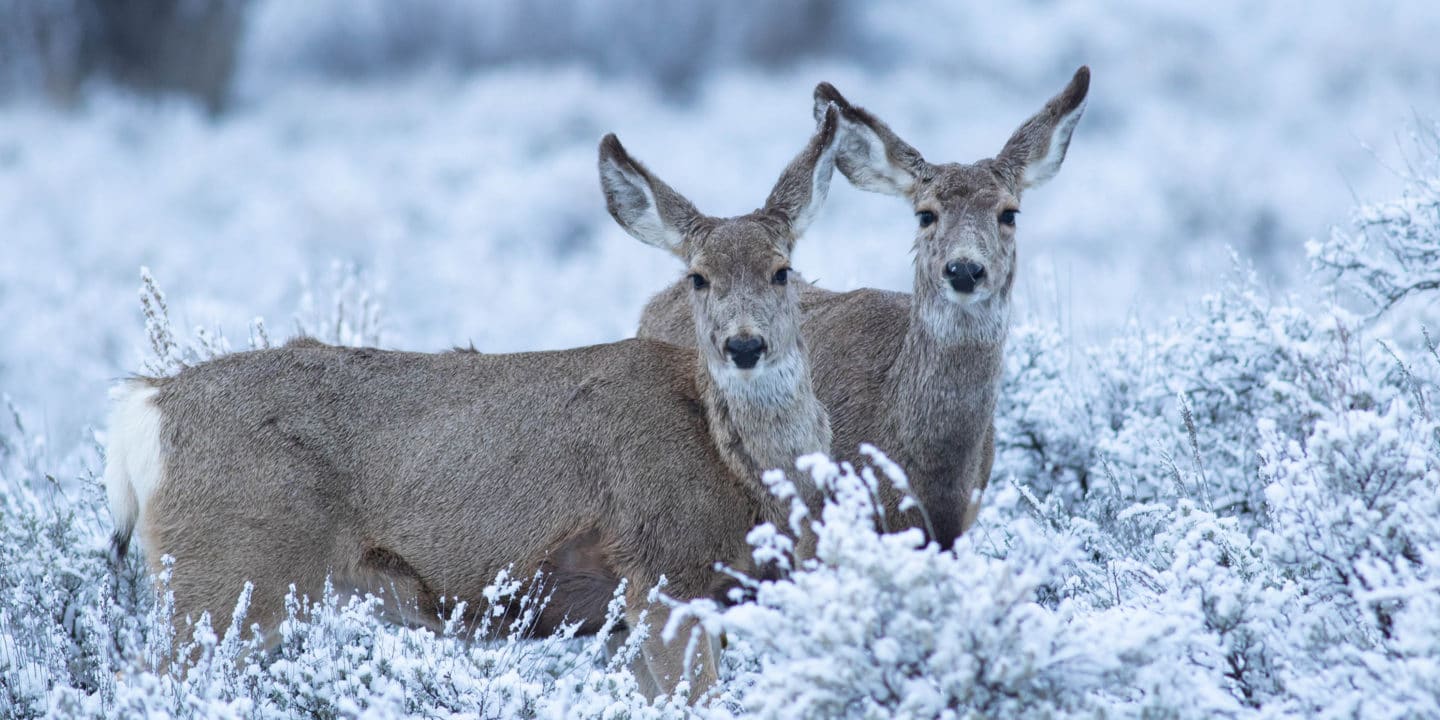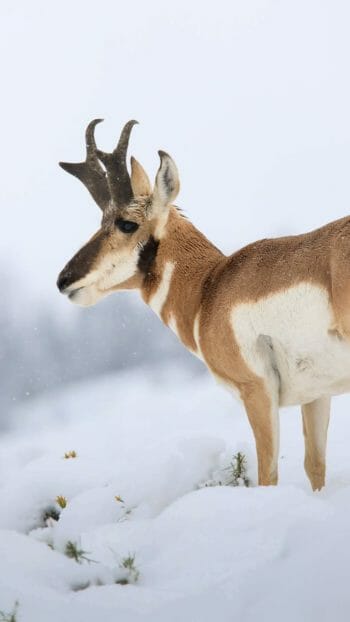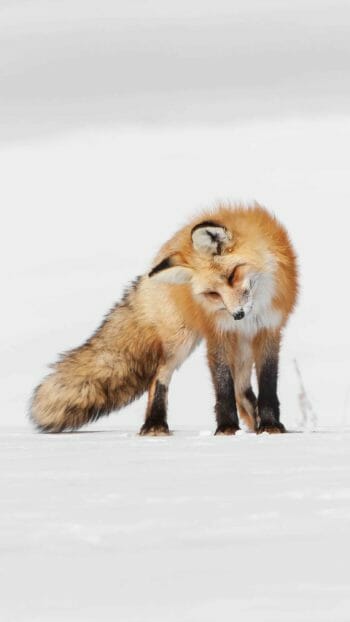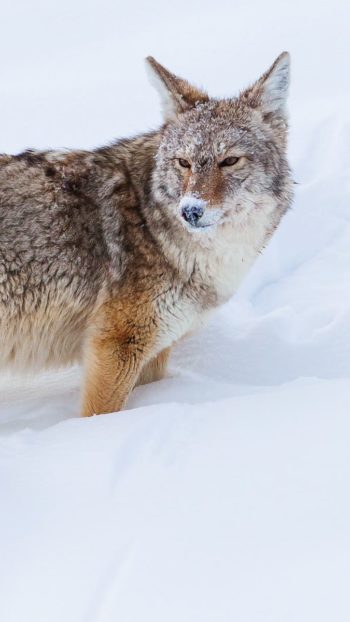Come November, Yellowstone National Park begins its transition into a quieter, colder and snow blanketed version of itself. 200 miles of roadway in the park will close, leaving only the north and northeast entrances open, along with the 50 miles in between that remain accessible all winter. Sagebrush steppes, grasslands, forest floors, parking lots and boardwalks alike become one sweeping, nearly seamless tundra, broken only by the geothermal features that continue to steam and swelter.
Winter season is nothing like the summers of Yellowstone. Visitation slows down, wildlife behavior changes, and by December, snowmobiles and snowcoaches (a vehicle adapted to drive on top of snow) begin taking people into the park. Out of the 4 million people that visit Yellowstone throughout the year, only about 2% of them come between December and March. The consistent below freezing temperatures and more difficult accessibility is probably what deters the masses that flood into the park come summer. However, if you are prepared to embrace the cold, visiting during those winter months holds great rewards in wildlife watching, and exploring the geothermal wonders of Yellowstone National Park.
A wolf pack travels through the Lamar Valley in Yellowstone National Park.
Compared to heavier animals like the elk, wolves have a competitive advantage in snow. The fur around the pads of a wolf’s paw becomes thicker in winter, giving these canines a natural snowshoe, and combined with the fact that wolves are lighter in weight, they are able to run across the top of snow banks rather than having to struggle through them. Snow also makes finding wolves easier! In summer, taller vegetation and lack of color contrast can make this animal extremely difficult to spot, while in winter, nearly everything becomes a white canvas upon which the gray and black fur of a wolf pops.
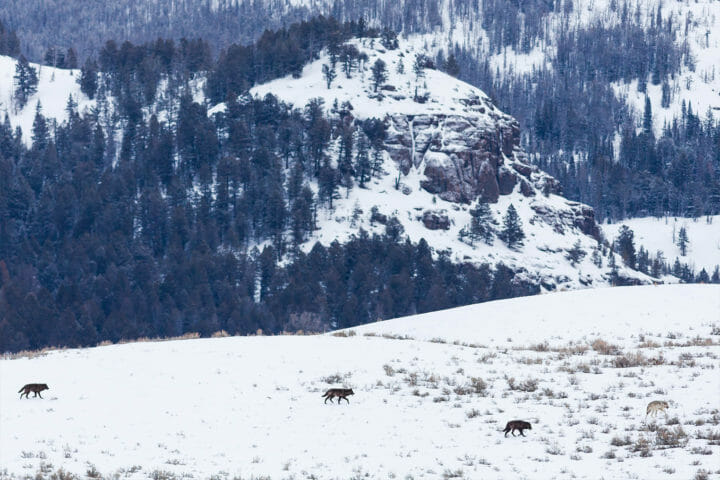
Wolves
Unlike bears, wolves do not hibernate for winter. On the contrary, this canine is very active throughout the snowy season. Come winter, the wolf’s diet becomes more than 96% elk, (rounding it out with approximately 3-4% bison and around 1.5% deer), while in summer that portion is only about 85% elk due to the greater variety of other mammals to hunt for. Almost daily, wolf packs will be out tracking and pursuing herds of these ungulates, seeking out the wounded and sickly, which will take less effort to chase down.
Currently there are 10 wolf packs in Yellowstone National Park, resulting in a population of about 123 wolves. Park biologists and citizen scientists study these wolves on a near daily basis, keeping track of individuals and pack composition. Wolf packs are not stable. The alphas, the number of individuals in the pack, the survival of pups – it all changes year to year. Some packs will kill members of another, some wolves are legally hunted in Montana, some are struck by vehicles, and some succumb to injuries or disease like canine distemper and mange. Survival is not easy in the wild for these animals. On average, a wolf only lives to 5 years of age, though some individuals have exceeded 10 years. Currently, the oldest wolf in Yellowstone is 11 years of age, the alpha female of the Wapiti Lake pack. This pack is one of the largest in the park with an estimated 19 members total. Its range has been documented to extend as far south as the Hayden Valley, and as far north as the Blacktail Deer Plateau, which is close to the Roosevelt Lodge. The Wapiti Lake Pack is one to look for in winter since they may travel into areas that are more accessible during that time of year.
North and northwest of the territory for the Wapiti Lake Pack is the range for the Phantom Lake Pack which has about 9 members, along with the the 8 Mile Pack which is 17 wolves in size. The Phantom Lake Pack is one of the newest in the park, forming in 2019 when 3 wolves from the 8 Mile Pack banded together. This is a great example of how fluid these packs can be throughout the years. Moving further into the northeast corner of Yellowstone you enter the territory for the Junction Butte Pack, which is potentially larger than the Wapiti Lake Pack, with over 20 members. This pack is often seen hunting in the Lamar Valley, and has even utilized the valley for den sites in the summer to raise pups. Packs of this size will be hunting on a daily basis, which makes them more likely to be sighted throughout the northern range of Yellowstone where thousands of elk migrate to in winter. Just like with humankind, if you want a guaranteed place to find people, look for the food!
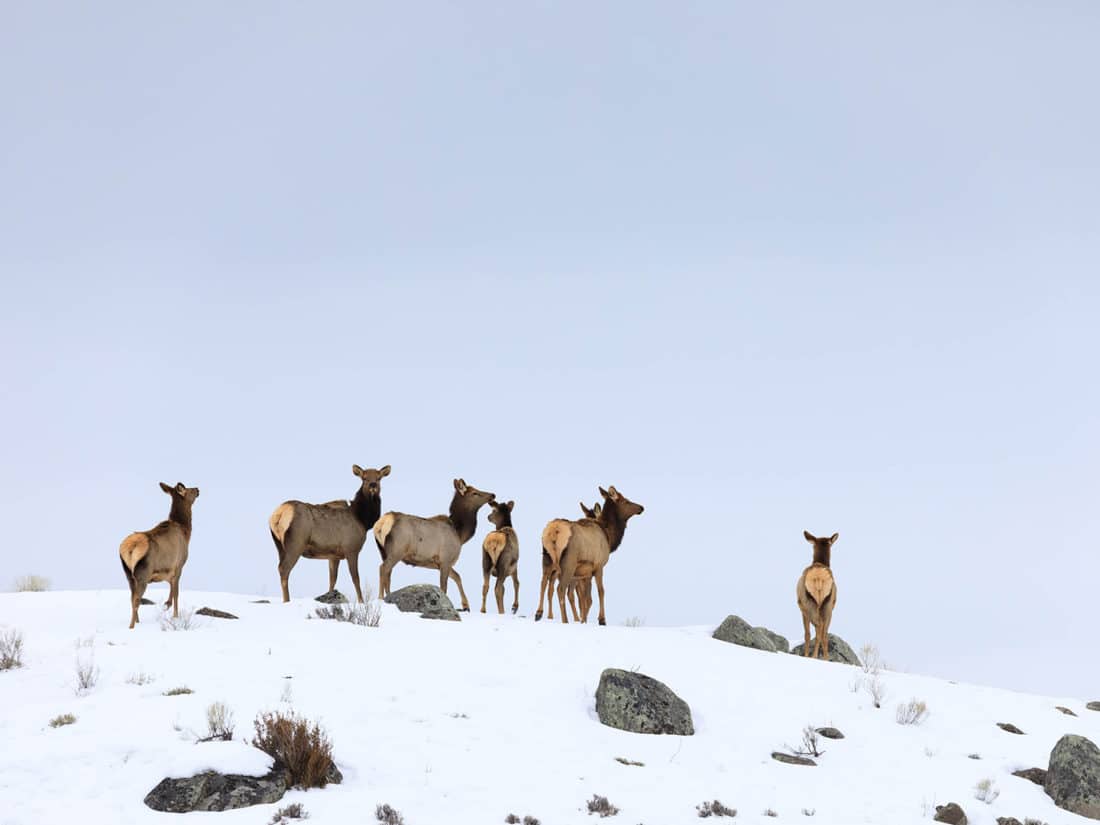
Elk
Approximately 20,000 elk will be dispersed amongst the forests, mountains and valleys in Yellowstone National Park in summer. This number drops to around 4,000 in winter as snowfall drives this animal out of higher elevations where food sources become unreachable. One of the largest wintering elk herds resides at the north end of the park, extending from Mammoth Hot Springs to the east through the Lamar valley, and spilling north out of the park boundaries into the Custer-Gallatin National Forest around Gardiner, MT. Areas at lower elevation will accumulate less snowfall throughout winter, making it easier for elk to dig for vegetation under that frozen blanket. In summer there is an ample amount of vegetation for elk to browse, ranging from the tender buds and leaves of willow to fields of green grass. It’s a stark contrast to winter where elk are primarily eating dead grasses found under potentially multiple feet of snow. This is a difficult period of survival for this animal, even with growing a thicker winter fur coat, many will freeze or starve to death and succumb to greater hunting pressures from wolves. Though it is easier to find elk in winter, since they will not migrate as far throughout the day in order to conserve energy, make sure to maintain a respectful distance to not disturb the elk and make them expend precious resources.
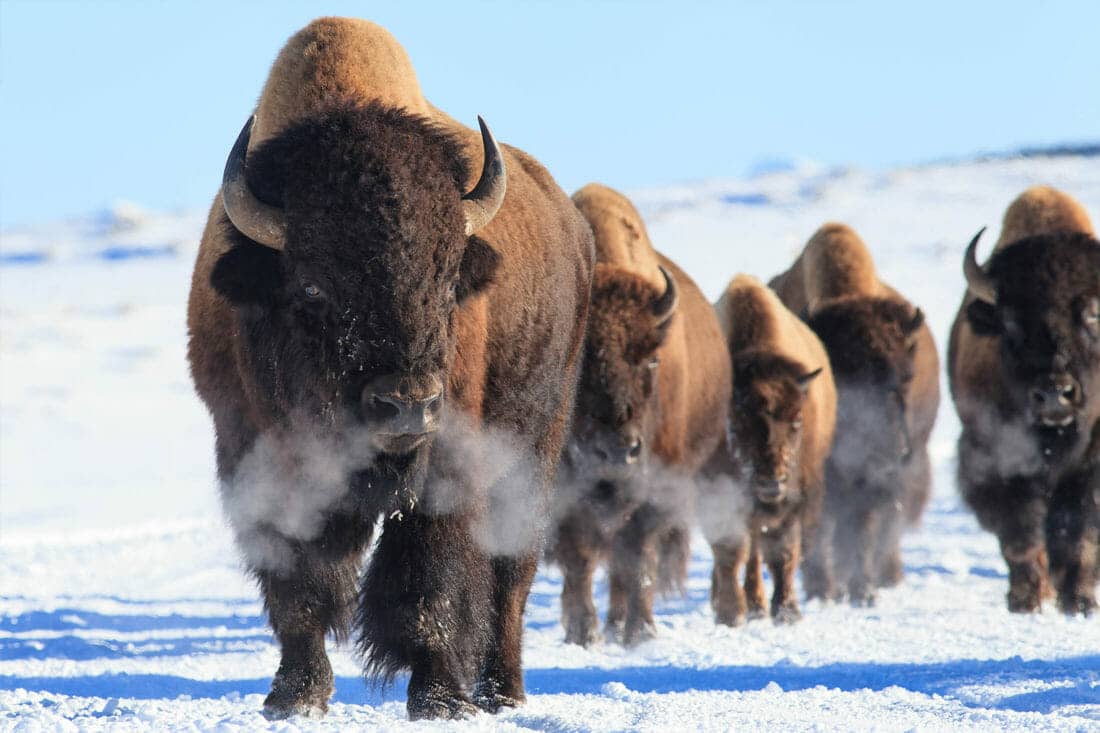
Bison
The ancestors of bison evolved during the last ice age over 200,000 years ago, meaning the current variety inhabiting Yellowstone National Park today are well equipped for the cold. Come winter, this massive beast grows a thick, wooly coat to regulate its body temperature. Bison might not start feeling chilly until temperatures drop to -40 degrees Fahrenheit! Fatty deposits will also begin to grow just under the skin, adding to the insulation. So, staying warm is not much of a challenge for Bison, but finding food can be. This animal has a distinctive method of foraging for food in winter, it will utilize that big head and powerful neck to sweep snow out of the way to access vegetation underneath, essentially turning the largest mammal in Yellowstone National Park into a living snow plow!
Similar to the elk, bison migrate into areas where survival is easier in winter. Some herds will move into the geothermal basins around Old Faithful, where the heat spilling out of springs and geysers will keep the ground clear of snow. Some vegetation will even continue to grow throughout winter in these areas due to the consistent steam. These bison might have it easier than the other groups that head north where there is less thermal activity and therefore more snow, but it has been found that these herds often live shorter lives. This is due to the vegetation they are consuming near geothermal features having more silica crystallizing on it, and as a result, the teeth of these bison wear down more rapidly from the silica, leading to them not being able to chew food later in life. This is a fascinating trade off, to freeze more in winter but live a longer life, versus staying warmer but not living as long. What would you choose?
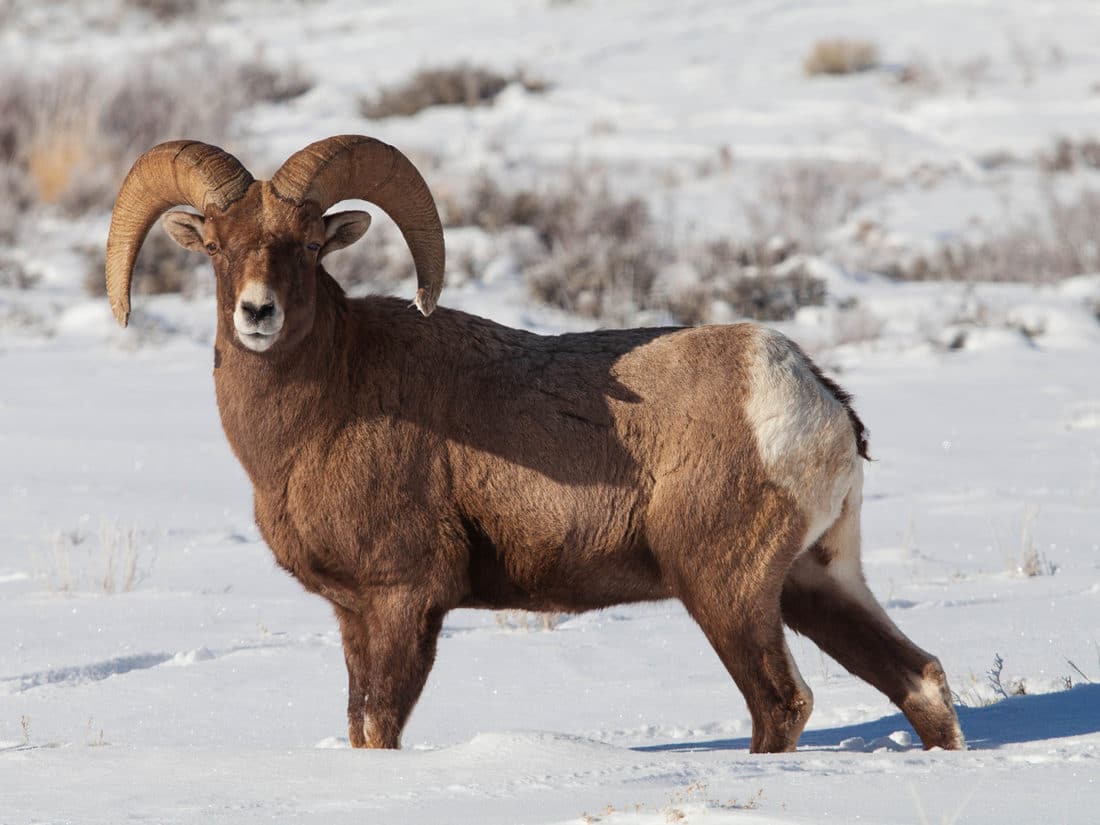
Bighorn Sheep
When thinking of “extreme” wildlife in Yellowstone National Park, this animal might be one of the first to pop up in your mind. The bighorn sheep is typically seen navigating nearly vertical cliff sides on mountains or in canyons. This ungulate evolved to have padded hooves, keen eyesight and an impeccable ability to balance on precipices that may only be 2 inches wide. Why would wildlife evolve to survive in such extreme conditions? The greatest advantage is the bighorn sheep’s ability to evade predation by escaping to steeper terrain. Even the agile mountain lion can find the rocky ledges that these sheep can traverse to be an obstacle when hunting.
Bighorn sheep might be the easiest to find come winter because the large quantities of snow that accumulate in the mountains where the sheep typically spend their summer forces them down into lower elevations where food is easier to find and maneuvering is not such a challenge. The bighorn sheep still prefers to find steep habitat for its wintering grounds, so they will often inhabit canyons for that season. One favored spot is a canyon near Mammoth Hot Springs at the north end of Yellowstone National Park.
Mountain Goat
This white, long haired, shaggy animal is another extremist in Yellowstone. Similar to bighorn sheep, the mountain goat also thrives in steep, rocky terrain found on mountainsides. Aside from appearances, this animal differs from the bighorn sheep in two major ways: It is not native to the Greater Yellowstone Ecosystem, and it will stay up in the mountains throughout the entire winter! The Greater Yellowstone Ecosystem is an area of about 18 million acres that includes both Yellowstone and Grand Teton National Park, along with surrounding US National Forest land. Naturally mountain goats do not extend further south than the northern mountain ranges of Idaho and Montana. At some point in the 1950’s, this species was introduced into the mountains along the east side of Yellowstone National Park, and from there, expanded. Chances are, this was to increase hunting opportunities in that area. The goats now have overlapping habitat with the native bighorn sheep, which means there is more competition for resources, and greater vectors for the spread of disease. As a result, the overall bighorn sheep population in Yellowstone has decreased since the mountain goat was introduced.
It is unfortunate that viewing this incredible species must be taken with a grain of salt, but that doesn’t take away from the fact they can survive in some of the most extreme habitats during one of the most extreme times of year. Throughout winter, mountain goats can still potentially be spotted throughout the Absaroka Mountain Range found in the northeast corner of Yellowstone. During this snowy time of year they will inhabit windswept cliff sides and ridges where less snow accumulates, and often stick to southern facing slopes which usually get more sun exposure throughout the day.
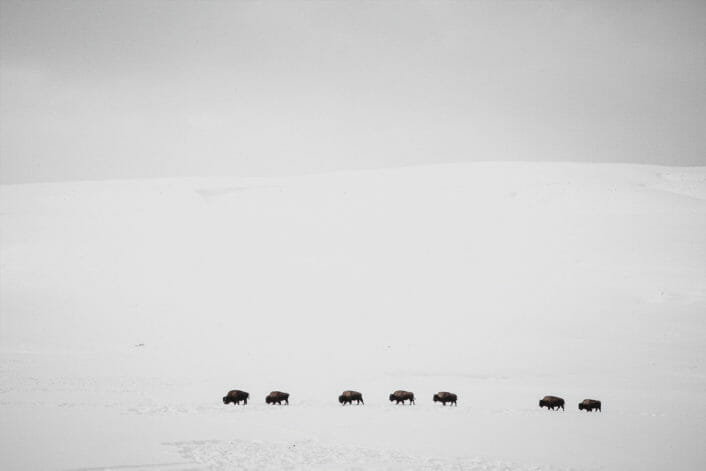
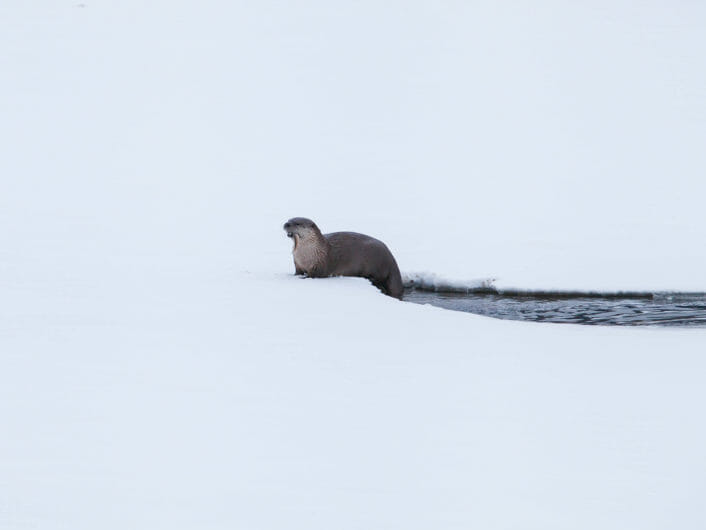
Small Creatures
The larger, charismatic wildlife gets a lot of attention, but there are a multitude of smaller animals that deserve some credit! One of the largest birds in Yellowstone will spend all year in the park. With an 8 foot wingspan and weighing up to 30lbs, the trumpeter swan is a hard bird to miss. Come winter, trumpeter swans will inhabit any waterway that does not freeze over, and the Yellowstone River is a great example. With enough thermal activity within the river, it continues to flow and grow vegetation for these birds to forage on even in the coldest of months.
The ermine, also known as the short tailed weasel, has the incredible adaptation to turn from chocolate brown in summer to stark white come winter. Except for the black tipped tail, this is a tough animal to spot when it blends in near perfectly with the snowy wonderland. Snowshoe hares also transition into a white colored phase for winter, along with having wide, fuzzy back paws in order to run across the top of snow. Their tracks are very distinctive, so keep an eye out for them if visiting the park during that season. These two animals, however, have this similar ability for very different purposes, ermine turns white in winter to camouflage itself from prey, while the hare is trying to hide from potential predators.
The American beaver survives winter in Yellowstone by caching food underwater near its den, as well as trekking out if the ice is thin enough to emerge from the frigid depths of ponds or rivers to forage. With a waterproof coat this animal can avoid succumbing to hypothermia when submerging itself in the cold and still stay dry and warm. The pika, a lesser seen small mammal in Yellowstone, prepares for winter throughout summer by collecting grasses and vegetation, placing that on rocks in the sun to dry and essentially cultivating its own hay which is then stored in underground burrows. Pika typically spend all winter under the snow, where colonies of this species will create tunnels to move around in. On warmer days though, if near a rocky boulder field, look for these small, gray creatures seizing an opportunity to sun themselves during a rare break from the usually cloudy, gray skies.
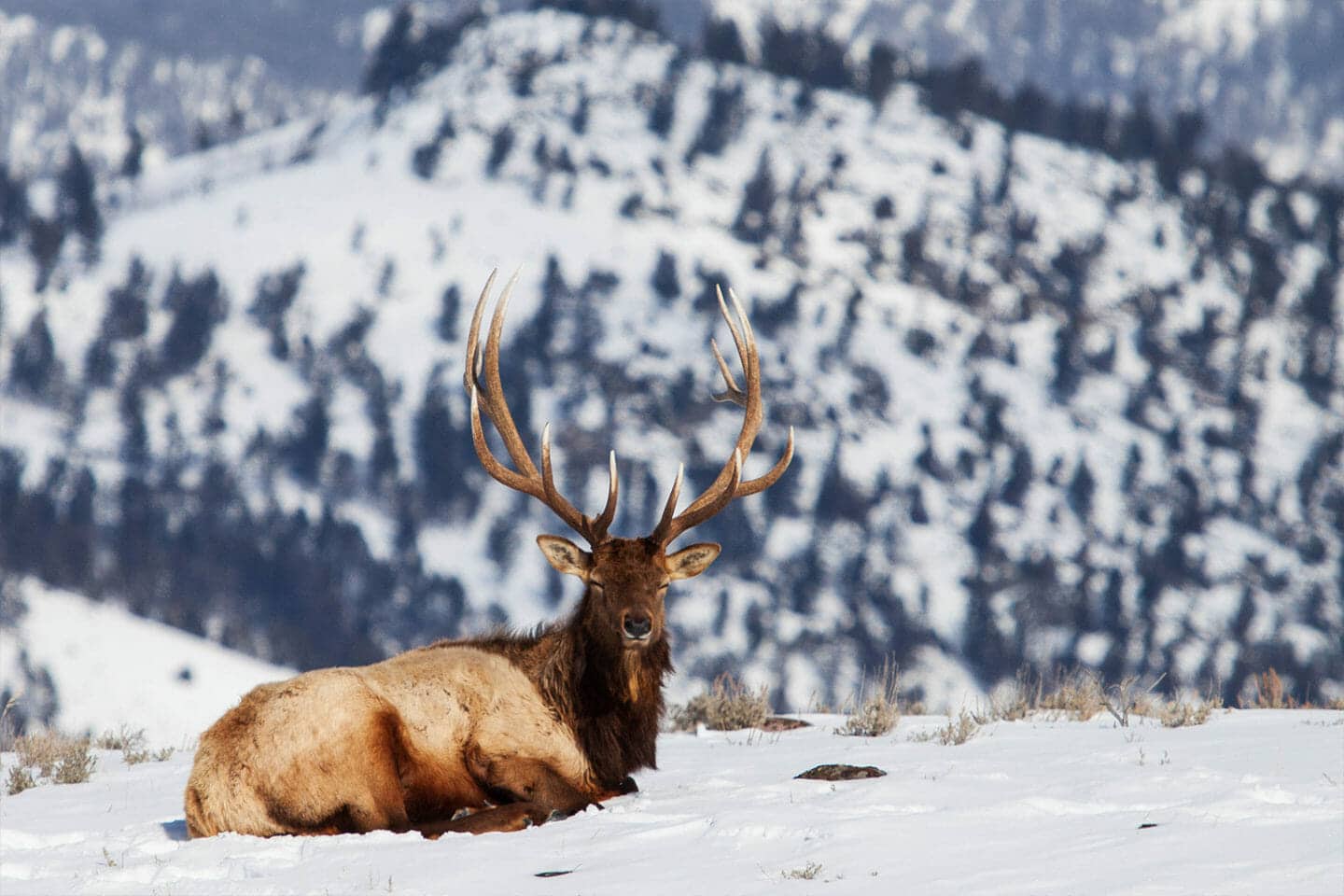
The best way to see wildlife in Yellowstone National Park is with a professional naturalist guide. A full day Winter Wildlife Safari is a driving tour through the northern area of the park, with opportunities to stop at multiple wildlife hot spots. A Full Day Snowshoe Safari offers guests a more immersive experience in nature with the opportunity to take in the local flora and fauna at a slower pace. A multi-day tour offers the best opportunities at spotting wildlife and you can choose from either a 2-Day or 3-Day wildlife safari tour.
FAQs
What animals can you see in Yellowstone in winter?
In winter, the animals of Yellowstone that are most commonly seen include bison, elk, coyotes, foxes, moose, bald eagles, and wolves. The snow-covered landscape makes it easier to spot wildlife, especially in open valleys like Lamar and Hayden.
Is winter a good time to visit Yellowstone for wildlife viewing?
Yes, winter is an excellent time to view the animals of Yellowstone. With fewer crowds and a quiet, snowy backdrop, animals are easier to spot as they move through the open terrain. Wolves, bison, and foxes are particularly active and visible during this season.
When are animals most active in Yellowstone?
The animals of Yellowstone are most active during early morning and late evening, especially in cooler seasons like spring and fall. In winter, wildlife can often be seen throughout the day as they forage and travel across snowy landscapes.
Can I see bears in Yellowstone in the winter?
Most bears in Yellowstone hibernate during winter, so it’s unlikely to see a bear at this time. Occasionally, a bear may emerge briefly if disturbed, but sightings are rare between November and March.
How can I visit Yellowstone in the winter?
To visit in winter, access is primarily by guided snowcoach or snowmobile tours, as most park roads are closed to regular vehicles. These tours offer safe, comfortable ways to explore and view the animals of Yellowstone in their winter habitat. Limited lodging is available in places like Mammoth and Old Faithful.

